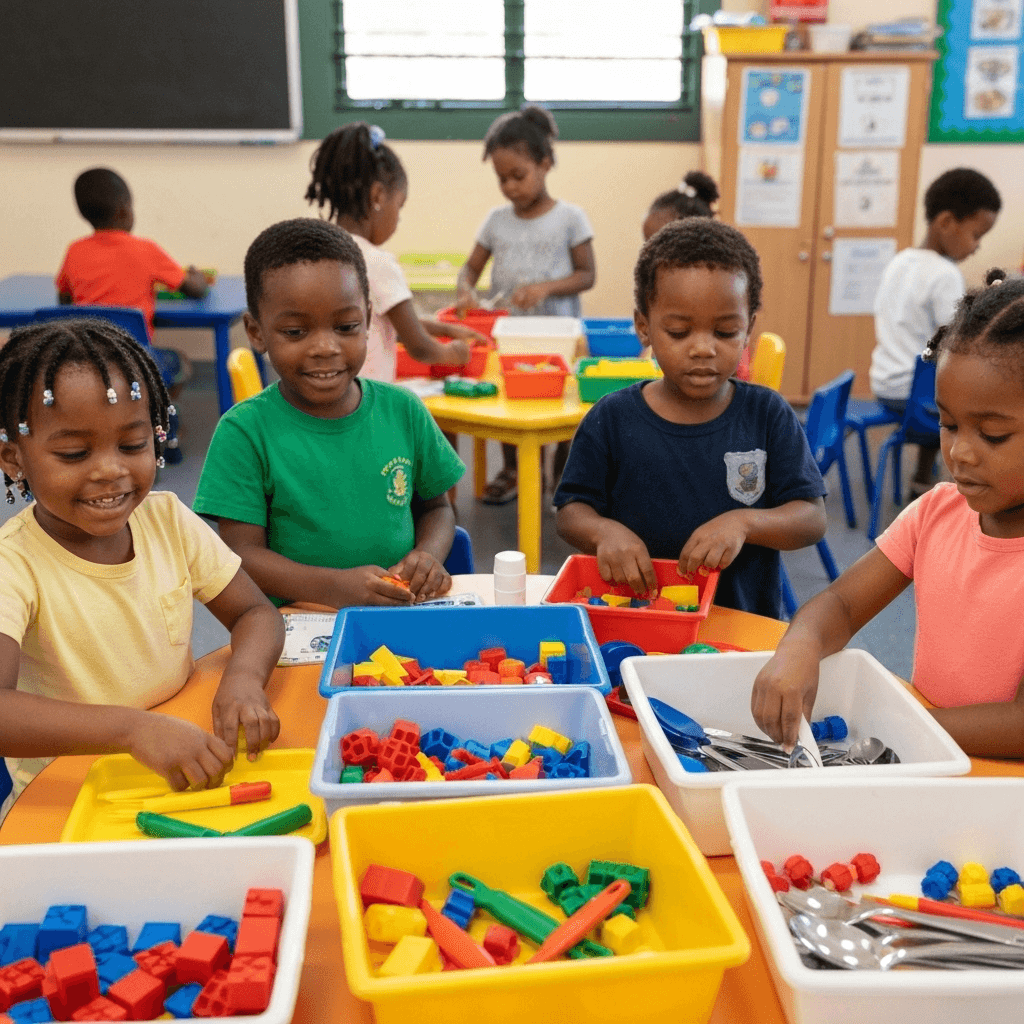Material Sorters
A hands-on physical science exploration where students investigate and classify materials based on their observable properties and characteristics.
Activity Overview
Material Sorters engages students in scientific investigation as they explore the properties of different materials through hands-on sorting and testing activities. Students develop observation skills while learning to classify objects based on characteristics such as texture, flexibility, transparency, and buoyancy. This inquiry-based approach builds foundational understanding of material properties and scientific classification.

Learning Outcomes
- Identify and describe properties of different materials
- Sort and classify objects based on observable characteristics
- Understand concepts of texture, flexibility, and transparency
- Investigate which materials sink or float
- Develop scientific vocabulary related to material properties
- Practice making predictions and testing hypotheses
- Record observations using simple charts and drawings
Curriculum Connections
Physical Science: Properties of materials
- Observable properties of objects and materials
- Sorting and classifying based on properties
- Understanding material characteristics
Scientific Inquiry: Investigation and classification
- Making observations and predictions
- Testing ideas through experimentation
- Recording and communicating findings
Implementation Steps
1Material Collection and Setup (10 minutes)
- Gather diverse collection of materials and objects
- Set up sorting stations with hoops or containers
- Prepare property cards with pictures and words
- Fill water tubs for sink/float testing
- Distribute recording sheets and pencils
2Introduction and Exploration (15 minutes)
- Show students the collection of materials
- Introduce property vocabulary: rough, smooth, hard, soft, flexible, rigid
- Demonstrate safe ways to test materials
- Allow free exploration time to touch and examine objects
- Encourage students to describe what they feel and observe
3Texture and Flexibility Sorting (15 minutes)
- Students work in small groups to sort by texture
- Create categories: rough/smooth, hard/soft
- Test flexibility by gently bending materials
- Sort into flexible and rigid categories
- Discuss findings and compare group results
- Record observations on data sheets
4Sink or Float Investigation (15 minutes)
- Students predict which materials will sink or float
- Test predictions by placing objects in water
- Sort materials into "sink" and "float" categories
- Discuss why some materials float while others sink
- Look for patterns in the results
- Record findings on observation charts
5Sharing and Reflection (10 minutes)
- Groups share their sorting results with the class
- Compare different ways materials were classified
- Discuss which properties were most useful for sorting
- Connect findings to everyday objects and materials
- Clean up materials and wash hands
Activity Variations
Mystery Box Sorting
Students reach into boxes to identify materials by touch alone, then sort based on what they felt.
Transparency Test
Add transparency testing by shining flashlights through materials to sort transparent, translucent, and opaque.
Magnetic Properties
Use magnets to test which materials are magnetic and sort into magnetic and non-magnetic categories.
Material Hunt
Send students on a classroom or school hunt to find materials with specific properties.
Differentiation Strategies
For Advanced Learners
- Create more complex sorting criteria with multiple properties
- Research why materials have different properties
- Design their own sorting challenges for classmates
- Connect material properties to their uses in everyday life
For Students Needing Support
- Start with fewer materials and simpler categories
- Use very distinct materials with obvious differences
- Provide picture cards showing property examples
- Work with a partner or adult helper
- Focus on one property at a time
Language Support
- Provide vocabulary cards with pictures and words
- Use gestures and demonstrations for property words
- Allow sorting without requiring written descriptions
- Encourage use of home language to describe properties
Assessment Rubric
Property Identification
- Excellent: Identifies multiple properties accurately
- Good: Identifies most properties with some help
- Developing: Identifies basic properties with support
- Beginning: Needs significant guidance
Sorting Accuracy
- Excellent: Sorts materials correctly and consistently
- Good: Sorts most materials appropriately
- Developing: Sorts with some errors or inconsistencies
- Beginning: Sorting needs significant support
Scientific Vocabulary
- Excellent: Uses property words correctly and confidently
- Good: Uses some property words appropriately
- Developing: Uses basic property words with prompts
- Beginning: Limited use of scientific vocabulary
Materials and Setup
Essential Materials
- Variety of materials: fabric, metal, plastic, wood, paper, rubber
- Sorting hoops or containers
- Property cards with pictures and words
- Water tubs for sink/float testing
- Towels for cleanup
- Recording sheets and pencils
Setup Tips
- Choose materials with distinct, obvious properties
- Ensure all materials are safe for student handling
- Have towels ready for water activities
- Create clear workspace boundaries for each group
- Prepare extra materials in case of loss or damage
